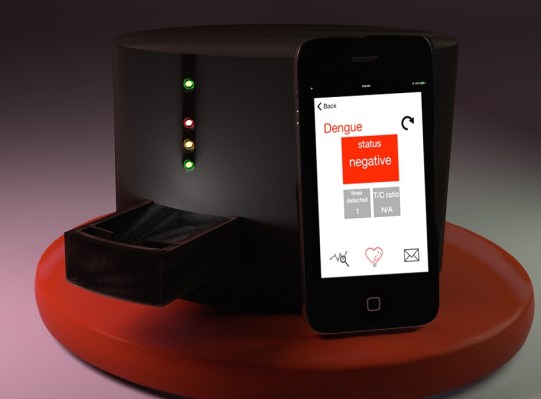Quick diagnosis of bloodborne diseases can very much be a matter of life and death, but bouncing results off a hospital can take hours or days — so the National Institutes of Health and Cornell University are working on a device called the FeverPhone that could cut that time to as little as 15 minutes.
“Imagine a glucose tester for your smartphone, where you can test for dengue instead of measure glucose,” said Cornell engineering professor David Erickson in a university news release.
Easy to deploy, quick to diagnose, and operable without expertise, the FeverPhone app would work with the breadbox-sized “Tidbit,” a largely automated machine that would take blood samples in and send the data to the phone for analysis.
Erickson is working with Saurabh Mehta, a Cornell professor of global health, to develop the device. It attracted the attention of the NIH’s Institute of Biomedical Imaging and Bioengineering, which wrote the team a grant for $2.3 million over four years. That grant was just formalized yesterday in an announcement from Senators Charles Schumer (D-N.Y.) and Kirsten Gillibrand (D-N.Y.).
The researchers will be partnering at the Escuela Superior Politécnica del Litoral in Ecuador; field validation will occur in the country’s most populous city, Guayaquil, alongside extant infectious disease monitoring infrastructure.
“A common feature of neglected tropical diseases, such as dengue, malaria, chikungunya, Zika and other viral and non-viral diseases, is its disproportionate burden on resource-limited countries,” explained ESPOL’s Washington B. Cárdenas, “where technology for surveillance, basic biomedical research, diagnosis and treatment are constrained.”
A cheap, quick, and reliable test for such diseases would be of incalculable value; as Cárdenas points out, countries like Ecuador are the main ones stricken by them and the resulting cost, in lives and other measures, is immense. For the record, Zika was not mentioned as part of the grant, but the technology should be adaptable to detect it.
The four years of the grant also indicate the proposed timeline for the device; the team hopes to have a final device ready for FDA approval by the end of that period.
